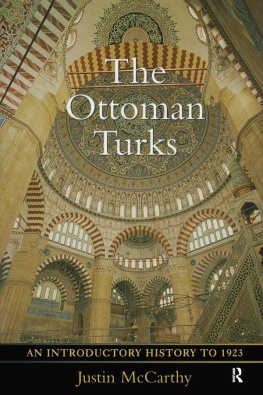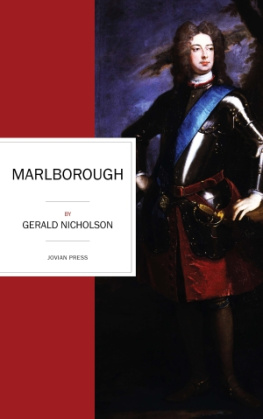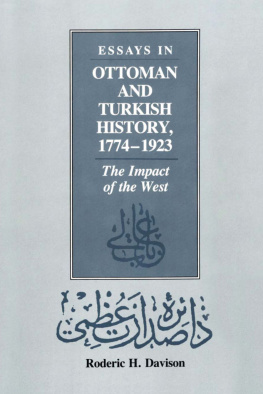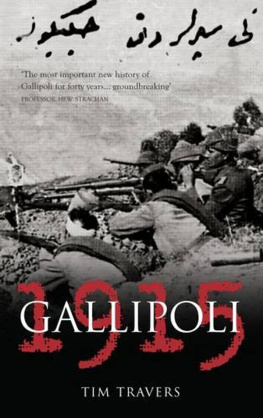Justin Mccarthy - The Ottoman Turks: An Introductory History to 1923
Here you can read online Justin Mccarthy - The Ottoman Turks: An Introductory History to 1923 full text of the book (entire story) in english for free. Download pdf and epub, get meaning, cover and reviews about this ebook. year: 2014, publisher: Taylor and Francis, genre: History. Description of the work, (preface) as well as reviews are available. Best literature library LitArk.com created for fans of good reading and offers a wide selection of genres:
Romance novel
Science fiction
Adventure
Detective
Science
History
Home and family
Prose
Art
Politics
Computer
Non-fiction
Religion
Business
Children
Humor
Choose a favorite category and find really read worthwhile books. Enjoy immersion in the world of imagination, feel the emotions of the characters or learn something new for yourself, make an fascinating discovery.
- Book:The Ottoman Turks: An Introductory History to 1923
- Author:
- Publisher:Taylor and Francis
- Genre:
- Year:2014
- Rating:5 / 5
- Favourites:Add to favourites
- Your mark:
- 100
- 1
- 2
- 3
- 4
- 5
The Ottoman Turks: An Introductory History to 1923: summary, description and annotation
We offer to read an annotation, description, summary or preface (depends on what the author of the book "The Ottoman Turks: An Introductory History to 1923" wrote himself). If you haven't found the necessary information about the book — write in the comments, we will try to find it.
The Ottoman Turks: An Introductory History to 1923 — read online for free the complete book (whole text) full work
Below is the text of the book, divided by pages. System saving the place of the last page read, allows you to conveniently read the book "The Ottoman Turks: An Introductory History to 1923" online for free, without having to search again every time where you left off. Put a bookmark, and you can go to the page where you finished reading at any time.
Font size:
Interval:
Bookmark:


The second courtyard of the Topkapi Palace. The chamber of the Imperial Council is directly to the right of the tower, with the harem stretching behind to the right. The domed gate (The Gate of Felicity) on the center-right leads to the throne room of the sultan. Janissaries and officials are gathered for an official reception of a European ambassador. (Antoine Ignace Melling, Voyage Pittoresque de Constantinople et des rives du Bosphore d'apres les dessins de M. Melling, Paris, 1819.)
An Introductory History to 1923

Justin McCarthy

First published 1997 by Pearson Education Limited
Published 2013 by Routledge
2 Park Square, Milton Park, Abingdon, Oxon OX14 4RN
711 Third Avenue, New York, NY 10017, USA
Routledge is an imprint of the Taylor & Francis Group, an informa business
Copyright 1997, Taylor & Francis.
All rights reserved. No part of this book may be reprinted or reproduced or utilised in any form or by any electronic, mechanical, or other means, now known or hereafter invented, including photocopying and recording, or in any information storage or retrieval system, without permission in writing from the publishers.
Notices
Knowledge and best practice in this field are constantly changing. As new research and experience broaden our understanding, changes in research methods, professional practices, or medical treatment may become necessary.
Practitioners and researchers must always rely on their own experience and knowledge in evaluating and using any information, methods, compounds, or experiments described herein. In using such information or methods they should be mindful of their own safety and the safety of others, including parties for whom they have a professional responsibility.
To the fullest extent of the law, neither the Publisher nor the authors, contributors, or editors, assume any liability for any injury and/or damage to persons or property as a matter of products liability, negligence or otherwise, or from any use or operation of any methods, products, instructions, or ideas contained in the material herein.
ISBN: 978-0-582-25655-2 (pbk)
British Library Cataloguing in Publication Data
A catalogue record for this book is available from the British Library
Library of Congress Cataloging-in-Publication Data
McCarthy, Justin.
The Ottoman Turks: an introductory history to 1923 / Justin McCarthy,
p. cm.
Includes bibliographical references (p. ) and index.
ISBN 0-582-25656-9 (CSD). ISBN 0-582-25655-0 (PPR)
1. Turkey History Ottoman Empire, 1288-1918. 2. Turkey Social
life and customs. I. Title.
DR486.M33 1996
| 956.1'015-dc20 | 96-16824 |
| CIP |
Set by 8 in 10/12pt Sabon
............................................................
The Turkish War of Independence: Mustafa Kemal and smet Paas.
Territorial losses of Bulgaria and the Ottoman Empire
I wish to thank the funding agencies and individuals whose training, advice, and financial assistance of past projects ultimately allowed me to write this book. I am especially grateful to those who helped me specifically with The Ottoman Turks Justin McCarthy Sr., Bruce Adams, Colin Heywood, Heath Lowry, David Morgan, William Ochsenwald, Lee Shai Weissbach, Rita Hettinger, Debbie Jordan, and the research committees of the Graduate School and College of Arts and Sciences of the University of Louisville. I am indebted to H.E. Niizhet Kandemir, Aykut Sezgin, and Mustafa Siyahhan of the Turkish Embassy in Washington, D.C. for their indispensable assistance in obtaining illustrations. The help of librarians and archivists at the University of Louisville, the Library of Congress, the School of Oriental and African Studies, The British Library, and the Topkapi Sarayi Mzesi was essential to the project. As always, my greatest thanks go to my wife, Beth, and my children for their support and understanding and the flowers, coffee, and brownies they brought up to my study to sustain me.
The publishers would like to thank the following for granting permission to reproduce illustrative material: Robert Harding Picture Library for the illustration on page 34 and The Illustrated London News Group for the illustrations on pages 194, 284, 328, 348 and 370.
To Anne Maureen
Overleaf
, built in 126065 by order of the vezir Sahib Ata. As Islamic rulers, the Rum Seljuks and their vezirs were patrons of Islamic architecture and culture. The building of medreses (Islamic schools) brought Islamic learning to Anatolia, cementing the Muslim character of the region and demonstrating the commitment of the rulers to orthodox Islam. (Turkey, General Directorate of Publications, Fotorafla Trkiye, Ankara, 1930.)

In the beginning of their recorded history Turks were nomads. Their original home was in Central Asia, in the vast grassland region that spreads north of Afghanistan and the Himalaya Mountains, west and northwest of China. By any normal standards of human comfort, Central Asia was a good place to leave. Its lands ranged from desert to forested mountains, but the general environment was bleak high plains that were only slightly more attractive than desert for human habitation. Temperatures in winter could fall below 34 C ( 30 F) and in summer rise to over 49 C (120 F). Average temperatures over most of the region, were below freezing in January, well over 27 C (80 F) in August. Spring was short, winter long, with snow covering the ground at an average depth of two and a half feet (75 cm) for almost half the year. Geographers classify some of the land as tundra, some as steppe.
The steppe grasses of their homeland best supported livestock and the Turks were primarily hunters and herdsmen. Because sheep devoured the grass in any one area fairly quickly, the Turks were forced to move from one pasturage to another in order to feed the flocks upon which they depended. Large groups would have quickly over-grazed the land and small groups could not defend themselves, so the earliest Turkish political units were tribes. Although the size of each tribe varied according to its environment and the success of its leadership, none could have been considered large or important.
Had the Turks remained solely in their tribes, they would have had little effect on w o r l d history, but they did not. When necessary the Turkish tribes proved able to cooperate. Out of mutual necessity they joined together for defence or conquest under strong leaders to form armies and ultimately empires. Accepting the overlordship of a strong leader (called ban or khan) meant that tribal feuds were diminished and the tribes could be organized for major conquests. The tribes remained as separate units, but they cooperated with one another. When united, the Turkish tribesmen were a formidable force. Turkish nomads were raised in harsh surroundings, taught from childhood the necessity of discipline and the use of weapons. Armed with bows and riding small steppe horses, they formed a swift light cavalry that could defeat more traditional standing armies with hit and run tactics. Battling against the Chinese and others, the Turks very early created nomad empires in central Asia and beyond.
Font size:
Interval:
Bookmark:
Similar books «The Ottoman Turks: An Introductory History to 1923»
Look at similar books to The Ottoman Turks: An Introductory History to 1923. We have selected literature similar in name and meaning in the hope of providing readers with more options to find new, interesting, not yet read works.
Discussion, reviews of the book The Ottoman Turks: An Introductory History to 1923 and just readers' own opinions. Leave your comments, write what you think about the work, its meaning or the main characters. Specify what exactly you liked and what you didn't like, and why you think so.








